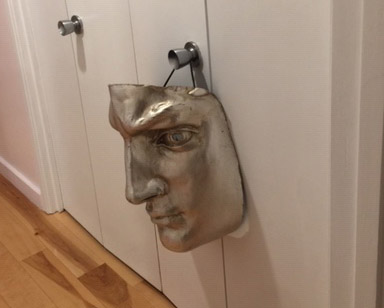 I love my amusing and clever readers who connect historical objects with present day realities. Santa Barbara reader FR sent me a twenty-five inch MASK she collected in Venice in the 1980s. She wonders about the history of masking, and the history of HER mask, the face of Michelangelo’s DAVID.
I love my amusing and clever readers who connect historical objects with present day realities. Santa Barbara reader FR sent me a twenty-five inch MASK she collected in Venice in the 1980s. She wonders about the history of masking, and the history of HER mask, the face of Michelangelo’s DAVID.
Let me riff, as FR does in her email to me, about masks we wear at this present time, and her magnificent DAVID mask.
I find this image of DAVID superimposed on various COVID masks throughout the world. I’m not talking about JUST David’s face as an image on those masks. This involves the humorous and traditional side of masks. They put an image, right on your face, of something irreverent, and make us smile. Make us remember that when others cannot see our WHOLE face, they see what we think about!
The Greatest Work of the Renaissance
In Florence, Italy where the original DAVID sculpture resides you might experience TWO identical works, both of huge DAVID. The original resides in the Accademia Gallery in Florence, where they moved it in 1910 from the outdoor Piazza Signoria. But of course, they made a copy for the Piazza Della Signoria (Duomo Square).
Before FR sent me her mask, I didn’t know Michelangelo carved DAVID from a stone brought to Florence across the Mediterranean in the middle 15th century. That huge block of marble offered such great promise that two notable sculptors attempted to make a sculpture from all FIVE tons it, but failed. In the 16th century three sculptors, including Leonardo and Michelangelo, competed for the commission to sculpt something for the plaza by the Duomo. Michelangelo won. He worked on the huge block of marble, making DAVID from 1501-1504, creating what some think of as the grandest work of the Renaissance.
How did it become an icon?
Why do we see David on COVID masks? Because it’s a world treasure. A full sized image of DAVID was sent to the Dubai Expo in October 2021, and that led to interesting cultural decisions. Presenters crafted an exquisite replica of resin using laser scans and 3D printing and then covered the fifteen foot work with marble dust. Then they needed to figure out how to display it in a culturally sensitive way. So they imagined it shipped in a glass, eighteen foot crate to Dubai with pillars of support for the glass strategically placed for “protections.” They put the glass shipping container and the pillars with DAVID inside on display, and not the WHOLE of DAVID. So ingenious!
Now Let’s Look at FP’s Venetian Mask
People wore it on top of their heads at the Carnival, no doubt. Crafted from papier-mache over a support, today made of resin, the mask feels light. In the 16th century the support came ONLY in reinforced papier Mache, perfected for the stage. Since the 16th century papier-mache artists made masks for performers of the Commedia dell Arte productions. They then painted the faces of the fantastic masks. Of course patrons didn’t see DAVID’s face on the theater stage in those days. They saw the Punchinello, the miser, and the curvy and desirable maiden.
Masks became an element of public performance in the Greek era. To see, but not see, a face comes with ancient ramifications. We use some masks for disguise, some for health, and some for fun. All revolve around what the face is and is NOT.
When the tradition of masking came to Venice, we see delicate silver and gold leafing as on FP’s DAVID mask, made for FUN and SHOW.
Next time you wonder with despair if you will ever NOT need to mask up, essentially putting on a face diaper, think of the rich tradition of masking. Give yourself some heart! And perhaps order yourself a DAVID mask, the conqueror of the GIANT, to wear. FP threatened to wear her DAVID to CVS, and I hope she does.